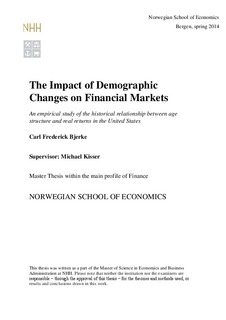The impact of demographic changes on financial markets : an empirical study of the historical relationship between age structure and real returns in the United States
Master thesis
Permanent lenke
http://hdl.handle.net/11250/221568Utgivelsesdato
2014Metadata
Vis full innførselSamlinger
- Master Thesis [4372]
Sammendrag
This paper studies the impact of demographic changes on financial markets, by testing the historical relationship between US age structure and the real return of the S&P 500 index. By critically discussing relevant research on the subject, we begin by providing an overview on where we stand today. Based on the theoretical framework of the Bakshi and Chen (1994) paper we then present two hypotheses, the life-cycle investment hypothesis and the life-cycle risk aversion hypothesis, as a motivation for the following empirical tests. The life-cycle investment hypothesis states that investors initially allocate most of their wealth in housing and other durables, before they gradually begin to invest in financial assets as they grow older. The life-cycle risk aversion hypothesis states that an investor’s risk aversion increases with age, increasing the risk premium demanded for holding risky assets. By replicating parts of this paper, we test both hypotheses against annual data from the time period 1950 until 2012. We also perform additional tests, using 5-, 10- and 20-year overlapping time periods to study the different components determining long-term real returns. In addition to age, the empirical tests include changes in consumption, dividend yields and term premiums, to improve the robustness of results.
The empirical results of this paper support the conclusion made by Bakshi and Chen (1994), that demographic changes have had a significant impact on capital market prices. We find annual changes in average age to be significantly and positively correlated with real returns in the following year, giving support to the life-cycle risk aversion hypothesis. We also find annual, 5-, 10- and 20- year changes in average age to be significantly and positively correlated with real returns during the same period, giving support to the life-cycle investment hypothesis. The historical correlation appears to increase with the length of each observation period, suggesting that demographic variables are best at explaining long-term movements in stock market prices. The additional variables related to consumption, dividend yields and term premiums are also significant in explaining real stock market returns.
